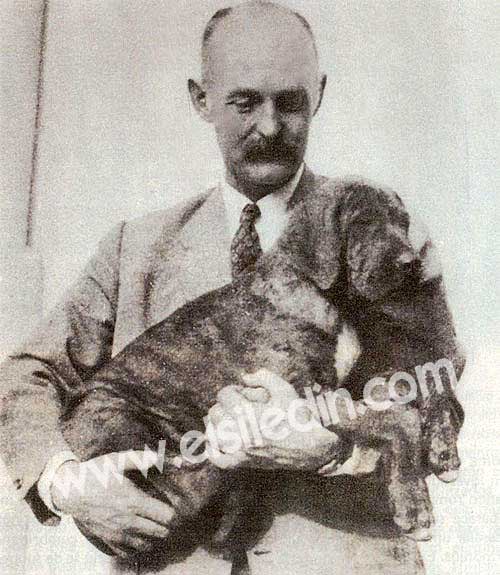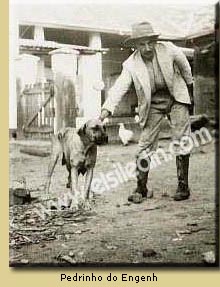
ARTICLES OF INTEREST
© 2013 - EL SILEDÍN - José Salvador - Murcia (España) 696 31 76 45 968 57 74 92



HISTORICAL INTRODUCTION TO THE BRASILICAN FILA BREED
By José Salvador Martínez
The major human migration in history took place once America was discovered. At the beginning of the XVI Century, the first Portuguese emigrants started to arrive to the Brasilian coasts, followed by many others from different Countries. The fact that dogs were not found, as native animals, in those lands, made the pioneers arrived accompanied by those breed of dogs already known in the European Countries, so as to help theirs owners with the tasks that they have been performing in their native lands : herding, hunting, guarding, etc., and, of course, in the case of America, holding dogs had a major importance, as they were used as guard dogs, as well as war dogs that would accompany soldiers during the colonization expeditions and in the fights with the native tribes of those lands.
Later on, the need of a big, strong and powerful dog, that was able to comply with the tasks of holding cattle and that could fight the Jaguars off their owners premises, as they were becoming frequently seeing near the men camps, attracted by the easy predatory effect on the domestic herds, was a necessity in Brasil.
To fight the Jaguar, one of the principal characteristics of the Fila, is its skin, that’s loose and thick, protecting the dog against the Jaguar’s attack, that’s, normally effected with its claws trying to get the cervix of the Fila, the loose and hard skin makes the claws of the feline slipper away and even though they can cause important wounds, it will allow the dog to escape alive.
In the XVIII Century, the economic conditions of this developing Country, calls for an stronger and more numerous hand labour, thus, the importation of black slaves from Africa started. In order to control these slaves, who will normally tried to escape from the plantations, a dog with an steady nerve and good nose, so as to be able to trace those men who where trying get away from the plantations, was needed.
Keeping all these needs in mind, some breeds were used in order to “create” the needed dog, that had to be able to accomplish all these different tasks and be good at all of them. Finally, and after centuries of crossing breeds, a type of strong, good sized dog, with great stamina and good nose, loose skin and a brave temperament was obtained, and that breed is known to-day under the name of Brasilian Fila.
Paulo Santos Cruz, author of the breed standard, defends the theory that the Brasilian Fila is a mixture of old holding dogs, such as the Bulldog, the English Mastiff and the Bloodhound. This theory, in my opinion, is probably the closest to the truth, as these breeds characteristics can be seeing in the actual Filas.
During the first half of the XX Century, the Brasilian Fila maintained and, continue fixing its characteristics mainly in the State of Minas Gerais ; where in the inland “facendas” (ranchs) they worked as “boiadeiro” (working with cattle), “onceiro” (hunting jaguars, which at that time they were quite common), and also as guard and protector of people and properties, not only in the ranchs “facendas”, but also accompanying their owners during the dangerous journeys, that they were forced to make, due to the great distances that existed from one town or village to another.
Those families of Filas mated among them, with no other rules than those dictated by Nature itself; therefore a great consanguinity existed in the offsprings, and was even worse with the lack of veterinarian care and poor nutrition.
Out of all these different families of Filas, some emerged with many common characteristics, allowing us to place them in four different big groups.
José Gomes de Oliveira : Probably the most known of the pioneer Fila breeders. In his “facenda”, located in Varginha, maintained a family of Filas that he had inherited from his father and grand father, and where the filas worked doing the “fazenda” work. From this group, some of the early breeders, such as Paulo Santos Cruz, for his Parnapuán Kennel, or Ennio Monte of ABC Kennel, got their foundation stock and, later on, kennels such as Aquenta Sol, that, after its closing, continued under the name of Engenho Velho, which most famous dog was “Lord”, his blood can still be traced in many of the Cafib dogs, as well as in dogs of the breeders of the Belo Horizonte area and in the Goiâs.
Pedrinho do Engenho : In his “fazenda” of Carmo de Minas had a Fila group also inherited from his ancestors which had maintained them from the XIX Century. He had a very important bunch of the “ceniza” (ash) color, and from this family line got some dogs, Paulo Santos Cruz, a female called “Fera de Parnapuán”, (in those days in was normal in Brazil to name the dogs got in “fazendas” with the name of the kennel, even though they had not bred them). Ennio Monte also used and bred with dogs from this family, as well as, W.F. Chalmers, owner of the Jaguara kennel, who bought from Pedrinho his first dog called “Leo da Jaguara”. From these Kennels, the line of those Filas was used by other breeders who still keep it. The Jaguara strain can still be seeing in some kennels of the Belo Horizonte area and, the oldest blood of that breeder, can be found in the Tabayara linage, though it can also be found, in less amounts in other Brazil areas.
Joao Silva : In his “fazenda” of Bela Vista, bred Filas that had also inherited from his father and grand father, in the City of Itanhandú, south of Minas Gerais. This blood contributed in the stock of other breeders, mainly through the blood of “Leâo”, who appears in the major part of the pedigrees of Cafib dogs, as well as through other dogs, that had been obtained from members of that Club.
Several members of the Reis family “fazendeiros” (ranchers) of the Varginha area, who had been breeding Filas from early XX Century, maintained also a very important pure Fila nucleo, that has no continuity as a line nowadays, as through the years, none of the members of the family has maintained an interest in the breeding of Filas, and the dogs from this family group mixed with others.
In 1954 the Fila, made his entrance in Europe, Dunga de Parnapuán was imported by H.R.H. Albretch Von Bayern in Alemania. Two other females from the Parnapuán Kennel were also imported. Those dogs, plus, some others, that also came from Brazil, mainly from the mentioned Kennel, started the lines from where the Fila begun in Alemania.
Later than in Alemania, in 1956, the breeding of Filas started in Holland, basing them also from the Parnapuán Kennels.
From those Countries the Brasilian Fila moved to other European Countries including Spain.
In Spain, those dogs, bred to others imported directly from Brazil, mainly by the Pugilato Kennel, started the stock from where the breeding of Filas was based during the early years.
As it normally happens, not all the dogs were equally valuable for breeding, some of them being simply marvellous and others not desirable, as they show a lot of mixed influence from other breeds.
From 1994 on, some dogs and bitches have been imported from CAFIB (Clube de Aprimoramento do Fila Brasileiro) by Spanish breeders. From these Kennels, the blood line of those dogs, have been purchase by the rest of the Spanishs Kennels, as well as by the rest of the World, as there are a lot of Countries that believe in the work that some breeders in Spain are doing and therefore, had decided to add the Spanish’s Fila blood to their own lines.
In some areas of Brazil, the Fila has not changed their original work and way of life in the “fazendas” yet, working with cattle and guarding, and living as their ancestors lived; but, it is not so in many places were we can found the Fila dog.
This breed, from the date of their official recognition in 1946, started to move from the “fazendas” to urban areas, where the Fila’s task is to guard either the small house, apartments, flats or properties, as well as acting as personal guard and protector, and this is what the majority of the Filas do in Countries outside Brazil.
But, today, we can also see the Fila in the kennels as stud dogs for the breed.
Jose Salvador Martinez 2004
By José Salvador Martínez
The major human migration in history took place once America was discovered. At the beginning of the XVI Century, the first Portuguese emigrants started to arrive to the Brasilian coasts, followed by many others from different Countries. The fact that dogs were not found, as native animals, in those lands, made the pioneers arrived accompanied by those breed of dogs already known in the European Countries, so as to help theirs owners with the tasks that they have been performing in their native lands : herding, hunting, guarding, etc., and, of course, in the case of America, holding dogs had a major importance, as they were used as guard dogs, as well as war dogs that would accompany soldiers during the colonization expeditions and in the fights with the native tribes of those lands.
Later on, the need of a big, strong and powerful dog, that was able to comply with the tasks of holding cattle and that could fight the Jaguars off their owners premises, as they were becoming frequently seeing near the men camps, attracted by the easy predatory effect on the domestic herds, was a necessity in Brasil.
To fight the Jaguar, one of the principal characteristics of the Fila, is its skin, that’s loose and thick, protecting the dog against the Jaguar’s attack, that’s, normally effected with its claws trying to get the cervix of the Fila, the loose and hard skin makes the claws of the feline slipper away and even though they can cause important wounds, it will allow the dog to escape alive.
In the XVIII Century, the economic conditions of this developing Country, calls for an stronger and more numerous hand labour, thus, the importation of black slaves from Africa started. In order to control these slaves, who will normally tried to escape from the plantations, a dog with an steady nerve and good nose, so as to be able to trace those men who where trying get away from the plantations, was needed.
Keeping all these needs in mind, some breeds were used in order to “create” the needed dog, that had to be able to accomplish all these different tasks and be good at all of them. Finally, and after centuries of crossing breeds, a type of strong, good sized dog, with great stamina and good nose, loose skin and a brave temperament was obtained, and that breed is known to-day under the name of Brasilian Fila.
Paulo Santos Cruz, author of the breed standard, defends the theory that the Brasilian Fila is a mixture of old holding dogs, such as the Bulldog, the English Mastiff and the Bloodhound. This theory, in my opinion, is probably the closest to the truth, as these breeds characteristics can be seeing in the actual Filas.
During the first half of the XX Century, the Brasilian Fila maintained and, continue fixing its characteristics mainly in the State of Minas Gerais ; where in the inland “facendas” (ranchs) they worked as “boiadeiro” (working with cattle), “onceiro” (hunting jaguars, which at that time they were quite common), and also as guard and protector of people and properties, not only in the ranchs “facendas”, but also accompanying their owners during the dangerous journeys, that they were forced to make, due to the great distances that existed from one town or village to another.
Those families of Filas mated among them, with no other rules than those dictated by Nature itself; therefore a great consanguinity existed in the offsprings, and was even worse with the lack of veterinarian care and poor nutrition.
Out of all these different families of Filas, some emerged with many common characteristics, allowing us to place them in four different big groups.
José Gomes de Oliveira : Probably the most known of the pioneer Fila breeders. In his “facenda”, located in Varginha, maintained a family of Filas that he had inherited from his father and grand father, and where the filas worked doing the “fazenda” work. From this group, some of the early breeders, such as Paulo Santos Cruz, for his Parnapuán Kennel, or Ennio Monte of ABC Kennel, got their foundation stock and, later on, kennels such as Aquenta Sol, that, after its closing, continued under the name of Engenho Velho, which most famous dog was “Lord”, his blood can still be traced in many of the Cafib dogs, as well as in dogs of the breeders of the Belo Horizonte area and in the Goiâs.
Pedrinho do Engenho : In his “fazenda” of Carmo de Minas had a Fila group also inherited from his ancestors which had maintained them from the XIX Century. He had a very important bunch of the “ceniza” (ash) color, and from this family line got some dogs, Paulo Santos Cruz, a female called “Fera de Parnapuán”, (in those days in was normal in Brazil to name the dogs got in “fazendas” with the name of the kennel, even though they had not bred them). Ennio Monte also used and bred with dogs from this family, as well as, W.F. Chalmers, owner of the Jaguara kennel, who bought from Pedrinho his first dog called “Leo da Jaguara”. From these Kennels, the line of those Filas was used by other breeders who still keep it. The Jaguara strain can still be seeing in some kennels of the Belo Horizonte area and, the oldest blood of that breeder, can be found in the Tabayara linage, though it can also be found, in less amounts in other Brazil areas.
Joao Silva : In his “fazenda” of Bela Vista, bred Filas that had also inherited from his father and grand father, in the City of Itanhandú, south of Minas Gerais. This blood contributed in the stock of other breeders, mainly through the blood of “Leâo”, who appears in the major part of the pedigrees of Cafib dogs, as well as through other dogs, that had been obtained from members of that Club.
Several members of the Reis family “fazendeiros” (ranchers) of the Varginha area, who had been breeding Filas from early XX Century, maintained also a very important pure Fila nucleo, that has no continuity as a line nowadays, as through the years, none of the members of the family has maintained an interest in the breeding of Filas, and the dogs from this family group mixed with others.
In 1954 the Fila, made his entrance in Europe, Dunga de Parnapuán was imported by H.R.H. Albretch Von Bayern in Alemania. Two other females from the Parnapuán Kennel were also imported. Those dogs, plus, some others, that also came from Brazil, mainly from the mentioned Kennel, started the lines from where the Fila begun in Alemania.
Later than in Alemania, in 1956, the breeding of Filas started in Holland, basing them also from the Parnapuán Kennels.
From those Countries the Brasilian Fila moved to other European Countries including Spain.
In Spain, those dogs, bred to others imported directly from Brazil, mainly by the Pugilato Kennel, started the stock from where the breeding of Filas was based during the early years.
As it normally happens, not all the dogs were equally valuable for breeding, some of them being simply marvellous and others not desirable, as they show a lot of mixed influence from other breeds.
From 1994 on, some dogs and bitches have been imported from CAFIB (Clube de Aprimoramento do Fila Brasileiro) by Spanish breeders. From these Kennels, the blood line of those dogs, have been purchase by the rest of the Spanishs Kennels, as well as by the rest of the World, as there are a lot of Countries that believe in the work that some breeders in Spain are doing and therefore, had decided to add the Spanish’s Fila blood to their own lines.
In some areas of Brazil, the Fila has not changed their original work and way of life in the “fazendas” yet, working with cattle and guarding, and living as their ancestors lived; but, it is not so in many places were we can found the Fila dog.
This breed, from the date of their official recognition in 1946, started to move from the “fazendas” to urban areas, where the Fila’s task is to guard either the small house, apartments, flats or properties, as well as acting as personal guard and protector, and this is what the majority of the Filas do in Countries outside Brazil.
But, today, we can also see the Fila in the kennels as stud dogs for the breed.
Jose Salvador Martinez 2004



José Gomes de Oliveira
Diseñado por Informática Laciana






